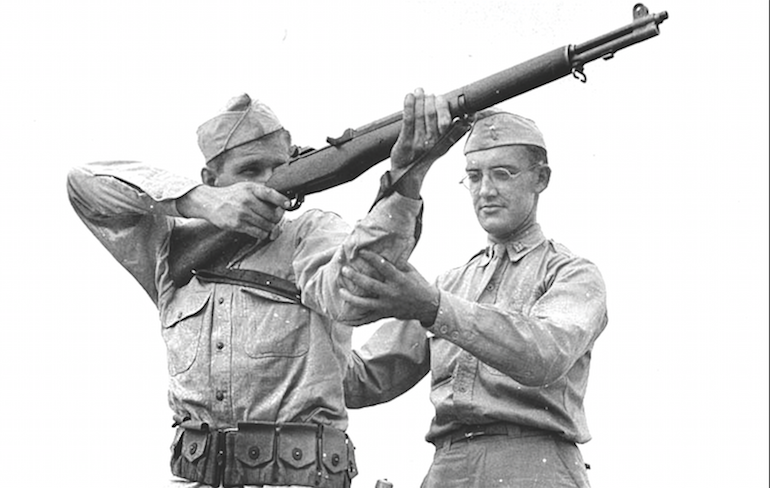Celebrating 150 Years of Winchester: The Second 50 Years
In the last post, we looked at Winchester’s earliest days of firearms and ammunition development, from its founding on May 22, 1866 through its first 50 years, which carried the company into the global fray that would become World War I.
That global conflict would thrust Winchester engineers, production workers and products themselves into the center of the melee and reshape the visibility of the brand and the importance it plays in the defense of America. Here are key dates as Winchester emerged from the conflict and powered through both good and bad economic times for the next 50 years of its century and a half of existence.

1917 – With war raging throughout Europe for several years and Germany’s resumption of unrestricted submarine attacks on merchant and civilian ships in the Atlantic, the United States enters the war. Winchester modifies the Enfield Number 14 Pattern to handle the U.S.-standard .30-06 Springfield cartridge, and builds more than half a million
U.S. Model 1917 Enfield rifles, the rifle that would go on to be used by the majority of American troops during the war.
1918 – Winchester engineers collaborate with John M. Browning to develop the legendary .50-caliber machine gun cartridge. For more than a half decade, Winchester supports the war effort with more than 870 million rounds of ammunition. The company also produces more than 47,000 Model 1918 Browning Automatic Rifles (BARs) during WWI. The Model 1897 pump-action shotgun is modified and nicknamed the “Trench Broom” by American soldiers.
1921 – With the war over for three years, Winchester turns its attention back on making products for the sportsman, introducing the legendary Super-X brand shotshell, a line of shotshells still sold—and extremely popular—today.
1925 – The flat-shooting .270 Winchester cartridge is introduced and becomes the famous through the writings of Outdoor Life’s Jack O’Connor. It remains one of the most popular, all-around big-game calibers today.
1927 – Winchester introduces Lubaloy copper-plated bullets.
1931 – The Model 21 side-by-side shotgun is introduced and establishes Winchester’s reputation for building top-quality sporting arms. That same year, struggling under the weight of the Great Depression, Winchester is bought by the Olin family’s Western Cartridge Company.
1932 – Dr. Fred Olsen patents a method for making smokeless powder underwater in small spherical grains. The new Ball Powder creates an instant competitive advantage for Winchester’s ammunition operation.
1935 – Western collaborates with Smith & Wesson to produce the .357 Magnum cartridge, which remains one of the most popular revolver calibers even today. That same year, the Western Cartridge Company would officially merge with Winchester to create the Winchester-Western Company.
1936 – The legendary Model 70 centerfire bolt-action rifle begins production and soon becomes known as the “Rifleman’s Rifle.”
1939 – Just over 20 years after the conclusion of the first World War, global conflict rears its ugly head again after Germany invades Poland, plunging Europe and ultimately the rest of the world into WWII. The first order from the U.S. military for the M1 Garand calls for 65,000 of the rifles to be built. Before the war is over, Winchester will build more than a half million such rifles.
1941 – In just 13 days, Winchester develops a light military carbine and cartridge and delivers it to government evaluators. Winchester would go on to build more than 800,000 of the six million M1 carbines made during the conflict.
1945 – After more than a half decade of war, Allied armies are victorious. In that time, 15 billion rounds of Winchester ammunition were delivered to American troops.
1950 – The western movie “Winchester ‘73” is released, starring Jimmy Stewart. Winchester-sponsored shooter Herb Parsons fills in for Stewart during the film’s trick shooting scenes.
1952 – NILO Farms is created as part of Winchester’s ongoing commitment to product development, field-testing and modern game management.
1956 – The .458 Magnum cartridge is introduced.
1959 – Two-time national champion King Buck, bred and trained at NILO Farms and Kennels, is the first and only dog to appear on the Federal Duck Stamp
1962 – The Mark 5 shot collar is introduced, enclosing the shot column and greatly improving patterns.
1963 – The .300 Winchester Magnum cartridge is introduced, filling an important performance niche between Winchester’s .264 and .338 Magnums. While the .270 has its fans, there are a good number of modern outdoor writers and experts who make the case that the .300 Win. Mag. is truly the best all-around big-game cartridge in the world.
1964 – Winchester is the first company to employ plastic hulls in the production of shotshells, gradually replacing the then common paper hulls. Plastic hulls, of course, are the norm today.
1965 – Winchester introduces the legendary AA shotshell. Its durable one-piece compression-formed hull is ideal for reloading and quickly becomes the “go-to” shell for millions of clay target shooters. That same year, the “Horse & Rider” image, while long a part of the Winchester brand since 1919, is officially registered as a company trademark.




